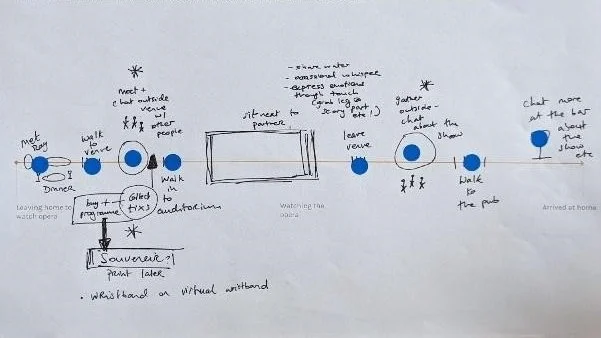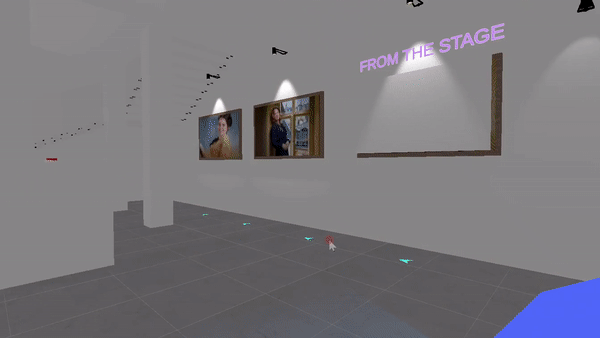Designing and Evaluating a VR Lobby for a socially enriching remote Opera watching experience
Presented at:
IMX 2022 Work in Progress, Jun 2022
Artistic Musical Society of Pousos, Dec 2021
VR Days Europe (remote), Nov 2021
Summary
Several social VR platforms support virtual entertainment events, however, their value for post-show activities remains unclear.
Based on insights from a context-mapping focus group, we design a social VR lobby experience to enrich the motivations of theatre-goers.
We ran a usability test with pairs of designers & music lovers to improve the current lobby design, and are currently in the process of conducting the final controlled study to evaluate the effects of having the social VR lobby.
Keywords
Opera, social VR, virtual reality, post-experience
Skills
Unity3D (C#), Blender, SteamVR, Git, Github, Focus group (Design workshop), Contextual inquiry, Think aloud, VR Usability testing, Mixed-method research
Researchers
Sueyoon Lee, Irene Viola, Zhirui Guo, Nacho Reimat, Pablo Cesar
Goal
Recently, operas have been produced and delivered online and those digital operas give individuals easier access to watch opera.
However, with the digital opera, the audience loses the chance of social interaction with each other that usually happens when watching opera physically together.
The goal of this project is to support social interaction between remote opera audiences through a social VR Lobby, thereby enhancing their remote theatre experiences.
Ideating VR Interaction Space
I conducted a context mapping focus group session with six VR and opera experts to brainstorm design ideas for VR interaction space for remote opera watching.
After analysis, we decided to build a VR lobby that supports social interaction, specifically the 'after opera watching' experience.
A user journey of a typical opera visit
Braindrawing of VR communication space
Accompanied slides
Concept Development
It was an iterative process of creating a new environment, interaction, and experiences, as immersive VR experience requires various elements to blend in harmoniously. I played different genres of VR games, tried social VR platforms, and referenced interior and architecture magazines to design 3d interfaces.
test 1
test 2
test 3
Initial VR Lobby Design
While there were many interesting ideas, we decided to base the design on the fundamental needs of theatergoers. We found that there are four motivations for people going to the theater: intellectual, social, emotional, and spiritual engagement.
Thus, the social VR Lobby consists of four rooms, each supporting one of the motivations: a bar for social; an info booth for intellectual; a photo zone for emotional; and an interactive stage for spiritual engagement.
The lobby was built with Unity3D (C#) and Blender.
Room 1:
Bar (Social)
Visitors can share their reflections on the opera by answering the pop quizzes at the bar.
Room 2:
Info Booth (Intellectual)
Visitors can meet the casts and the production team in an interactive avatar form so that they can learn more about the backstage.
Room 3:
Photo Zone (Emotional)
Visitors can take photos and save memories with props and background images of and from the opera.
Room 4:
Interactive Stage (Spiritual)
Visitors can change the major component of the opera - color theme, seasonal theme - and see how it affects the overall mood of the opera.
Usability Test
We invited five pairs of designers or opera/music lovers to experience and ask them for feedback on the lobby experience. They first watched a short opera in VR and then sent to the VR lobby. People were asked to use 'think aloud' when exploring the lobby.
We gathered insights on usability and design/technical issues. We chose the 'interactive stage' and a 'Photo Zone' to continue the development.
Final Lobby Design
The VR lobby was meticulously designed to encourage social interaction for multiple visitors while still providing a complete experience for the individuals.
Room 1:
Photo Zone
We added one more photo spot and an additional 'photo sending' experience while improving usability, including sound, haptics, interactions, etc.
Room 2:
Interactive Stage
A new interaction point - changing the stage setup - was added in the Interactive Stage that could satisfy visitors' needs for more experience in general.
Analysis
We ran a between-subject controlled study comparing individual (N=20) and pair (N=20) participants to test the benefits of the VR Lobby in terms of the social aspect.
We collected and analyzed qualitative (interview, observation) and quantitative data (questionnaire).
Reference
S. Lee et al., "Designing and Evaluating a VR Lobby for a Socially Enriching Remote Opera Watching Experience," in IEEE Transactions on Visualization and Computer Graphics, vol. 30, no. 5, pp. 2055-2065, May 2024, doi: 10.1109/TVCG.2024.3372081.
Sueyoon Lee, Alina Striner, and Pablo Cesar. 2022. Designing a VR Lobby for Remote Opera Social Experiences. In ACM International Conference on Interactive Media Experiences (IMX '22). Association for Computing Machinery, New York, NY, USA, 293–298. https://doi.org/10.1145/3505284.3532980













